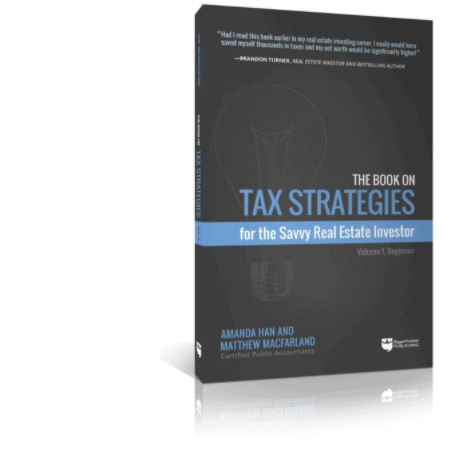“Anyone may so arrange his affairs that his taxes shall be as low as possible; he is not bound to choose that pattern which will best pay the Treasury; there is not even a patriotic duty to increase one’s taxes.” – Gregory v. Helvering, 69 F.2d 809, 810 (2d Cir. 1934)
I bet it is no surprise that your tax bill is one of the largest expenses you pay, often more significant than your housing and healthcare expenses. If you have spent any measured amount of time on BiggerPockets, you probably have a high-level understanding that investing in real estate could help you offset some of your tax burdens.
For example, depreciation could help you shelter passive income (and possibly your active income) from your rentals. Using a 1031 exchange when you sell a property could help you defer your depreciation recapture and tax on capital gains. You could remove equity from your rentals tax-free through a refinance and invest in more property.
However, most investors who enter the real estate arena know little about strategically reducing their tax bills. If you’re like me, we grew up being trained to pay taxes. Yes, trained.
Do you think I’m kidding?
I know for me, I was raised to go to school, get a great job, buy a house, get married, start a family, and contribute to my 401(k).
With this “plan”, the only chance of reducing my tax burden was to take a standard deduction, deduct my mortgage interest (if I could), get a tax credit for my kid, defer my income to retirement, and hope the tax rate would be low by the time my career came to a close and I had to pull from my retirement fund.
Somehow, with all of this, I still would wind up paying thousands of dollars in taxes.
It turns out that hope is not a strategy.
How the best in real estate approach taxes
I’m not a CPA, accountant, or tax guru. As with any advice, please consult a qualified tax strategist to understand how the information I’m about to share with you can apply to your unique situation.
What I’ve learned working with tax strategists and studying the wealthy is that there are better ways to approach reducing your tax bill. One of my favorite books on the subject is “Tax-Free Wealth“ by Tom Wheelright.
Overall, I have two critical takeaways from studying taxes.
First, there is a clear “order of operations” you must follow to maximize your tax savings. The traditional narrative I grew up with is not the correct strategy if you’re trying to reduce your tax bill significantly.
Second, the U.S. tax code is actually a treasure map that tells us where to invest our dollars. Real estate and business are two spaces where the IRS wants the private sector to solve problems. As a result, investors get the best tax breaks.
Wealthy individuals know how to combine a clear step-by-step strategy with the tax code’s “treasure map” to reduce their tax burden significantly. Why couldn’t you do the same?
Let’s talk about how you can.
Step 1: Take deductions (including depreciation)
Investing in a business (even if you have just one rental) allows you to take more deductions. Ordinary tax-deductible expenses include:
- Interest
- Depreciation
- Taxes
- Insurance
- Repairs and Maintenance
- Property Management Fees
- Utilities (Oil, Gas, Electric, Water, Phone, etc.)
- HOA Fees
- Professional Fees
- Snow Removal/Landscaping
- Travel Expenses
- Supplies
- Leasing Commissions
- Advertising/Marketing
- Business Mileage
- Education
- Bank Fees
- Employees & Independent Contractors
- Home Office Expenses
- Business Meals
The most significant deduction, which is borderline magical, is depreciation. The IRS understands that tangible assets (such as real estate) will break down over time. At some point, the carpet, cabinets, and HVAC will need to be replaced. In their eyes, it would be best if you, as an investor, keep the asset in good working order. Therefore, the gift of depreciation is awarded to help us offset costs and reinvest back into the property. You could also use passive depreciation to shelter passive income and keep it tax-free.

Dreading tax season?
Not sure how to maximize deductions for your real estate business? In The Book on Tax Strategies for the Savvy Real Estate Investor, CPAs Amanda Han and Matthew MacFarland share the practical information you need to not only do your taxes this year—but to also prepare an ongoing strategy that will make your next tax season that much easier.
Step 2: Focus on building passive income
There are two types of income: active and passive. If you want to enjoy lower taxes (and financial freedom), then you should focus on building passive income.
The IRS classifies employees or self-employed persons as active income earners, which get taxed at a higher rate. Business and investment income, on the other hand, is generally considered passive income and is usually taxed at a lower rate. It’s important to note that the number of hours you spend on any given activity doesn’t factor into the equation. Instead, it’s purely based on what the IRS determines.
For example, I have real estate notes that I spend no time managing, but it’s considered active income and taxed at ordinary income rates. Yet, my rental properties and partnerships take more time to manage and earn a good share of income but still get taxed at a lower rate because of the way the IRS classifies the income.
The big idea is that those who earn income through their own business or earn from a company they invested in will pay the lowest taxes. For more information on this, I suggest reading “The Cashflow Quadrant“ by Robert Kiyosaki.
Step 3: Lower your tax bracket through creative employment
Now that you have steps one and two, it’s time to partner with your tax strategist to look for ways to shift your income to lower tax brackets. You can do this by employing your dependents if you have any.
Yes, I really mean to hire your kids if you have extra work that they can cover for you. It’s legal.
If your child is under 18, they can work for you in your real estate business and earn up to their standard deduction (currently $12,950) before they have to pay taxes on income.
Just think, you could have your 16-year-old file paperwork, clean the office, keep the books, and maybe manage your social media. With what you pay them, they can use those funds for their expenses, save for college, start a Roth IRA, or invest alongside you.
The same strategy could apply to other dependents you support.
However, you have to be careful. The IRS is fully aware of this tax loophole and is purposely looking for anyone mischievously taking advantage of it. Ensure that whatever your dependent is hired for, they are actually doing their job. You can’t just place them on the payroll and not have them do anything. Otherwise, the IRS will call it out and disqualify the tax break.
Partner with your tax strategist to craft an accurate job description, pay scale, and maintain proper documentation before hiring any dependents.
Step 4: Reduce income through tax credits
There are a number of different tax credits you may qualify for. Speak with your tax strategist for a personalized look into your situation.
Credits are a dollar-for-dollar reduction of income. Some credits may apply to your personal tax situation, examples being the saver’s credit or child tax credits.
There are also credits that may apply to your business (energy credits, water credits, tax abatements, and more). Credits are another way the IRS incentivizes behavior, so be sure to know what you qualify for.
Step 5: Defer income to lower your tax bracket this year
If you still want to reduce your taxable income after moving through the first four steps, then you should consider deferring income. This means you can push aside part of your income to be reported towards next year’s taxes or later. This is helpful when you need to reduce your reported income just enough to be placed into a lower tax bracket.
It’s worthwhile to note that if you are still working a W-2 job, it may be beneficial for you to fund your retirement accounts to maximize employer matches and pensions.
If you choose to fund your retirement accounts, be sure to explore contributing to self-directed IRA accounts (SDIRAs) or other qualified retirement plans that are in your control. With these types of accounts, you have more options to invest in alternative assets like real estate while maximizing the tax code. For example, through an SDIRA, you can invest in:
- Real estate lending
- Fix and flips
- Buy and hold rentals
- Syndications and funds
Ask your tax strategist to create a model to see if funding these accounts will genuinely help your overall situation.
Closing thoughts
“In this world, nothing is certain but death and taxes.” – Benjamin Franklin
Taxes are among the most significant expenses eroding your wealth, along with investment fees and debt. Just imagine how much you could boost your investing journey by generating an additional $10,000, $20,000, or $50,000 in tax savings to reinvest.
Like most things in life, success leaves clues. Following the examples set by the brightest and most successful in our industry is a great way to achieve your own success. It’s in your best interest to sit down with a qualified tax strategist to see how you can implement the above strategies and start reaping the benefits.

